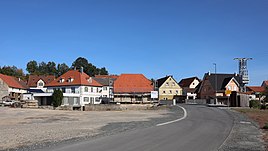Grafenholz
|
Grafenholz
Rentweinsdorf market
Coordinates: 50 ° 2 ′ 54 ″ N , 10 ° 49 ′ 3 ″ E
|
|
|---|---|
| Height : | 253 m above sea level NHN |
| Residents : | 40 (2014) |
| Postal code : | 96184 |
| Area code : | 09531 |
|
Grafenholz with mill
|
|
Graefenholz is a district of the Lower Franconian community Rentweinsdorf in the Haßberge district .
geography
The village is located in the eastern part of the district on the Baunach . Communal roads lead to Sendelbach , Treinfeld and Obermanndorf. The Breitengüßbach – Ebern railway is to the east of the village . The two closest stops are Rentweinsdorf and Manndorf. Federal road 279 runs west of Graefenholz .
history
The place name means "forest of the counts". Presumably the Counts of Truhendingen are meant, who owned the neighboring Sendelbach as an imperial fief. The first mention was in 1352, when the gentlemen of Altenstein received two goods in "Grefenholtz". In 1443 Seyfridt von Stein owned a farm in "Greffenholtz". In 1532 the von Rotenhan had jurisdiction in "Grefenholtz". After the Thirty Years War , a family still lived in the village. Other families took a few years to settle here. In 1585 "Greuenholtz" was a Würzburg fief of the Rotenhan. In 1628 they owned three estates in the village. In 1742 the Rotenhan village lords were in "Grafenholtz".
In 1818 the community association Sendelbach was established, consisting of the village Sendelbach and the hamlet of Graefenholz. In 1862 Sendelbach was incorporated into the newly created Bavarian District Office Ebern , where it belonged to the Baunach Regional Court. In 1871 Graefenholz had 67 inhabitants. The evangelical denominational school and parish was in Rentweinsdorf, 2.8 kilometers away. In 1900 the 397.02 hectare rural community of Sendelbach had 37 residential buildings and 176 inhabitants, of whom 3 were Catholics and 173 were Protestant. The Protestant Gräfenholz had 69 residents and 14 residential buildings. In 1925, 71 people lived in 14 residential buildings in Graefenholz. In 1950 the place had 101 residents and 15 residential buildings. He belonged to the district of the Catholic parish Ebern . A road bridge over the Baunach was built in the 1950s. In 1970 there were 61 and in 1987 50 inhabitants and 13 residential buildings with 13 apartments.
On July 1, 1972, the district of Ebern was dissolved and the municipality of Sendelbach became part of the Haßberg district. On January 1, 1978, the municipality of Sendelbach was incorporated into Rentweinsdorf and Gräfenholz became a district.
Former buildings
The "old" Graefenholz mill stood in Graefenholz until 2015.
For many, the mill was not only a point of contact for processing the harvested grain into flour, but also served as a power station for Graefenholz and Sendelbach in the early 1920s.
The mill operation was stopped in the early 1960s. One reason for this was that no further mills were allowed to be built in Germany after 1955, or only in exceptional cases and existing plants could not be expanded. That is why the Mill Shutdown Act was passed in 1957.
The Elflein family's transport company, which has existed since around 1930, was based in the mill until 1990.
Web links
Individual evidence
- ↑ Population of Graefenholz on the Rentweinsdorf website
- ↑ a b c Werner Schmiedel: Districts Ebern and Hofheim. In: Historical book of place names of Bavaria. Lower Franconia. Volume 2: Districts of Ebern and Hofheim. Commission for Bavarian State History, Munich 1973, ISBN 3-7696-9872-X , p. 17.
- ↑ a b Discover, Experience, Enjoy - Verwaltungsgemeinschaft Ebern, September 2017, p. 51. ( Memento of the original from September 19, 2018 in the Internet Archive ) Info: The archive link was inserted automatically and has not yet been checked. Please check the original and archive link according to the instructions and then remove this notice.
- ↑ Kgl. Statistical Bureau (ed.): Complete list of localities of the Kingdom of Bavaria. According to districts, administrative districts, court districts and municipalities, including parish, school and post office affiliation ... with an alphabetical general register containing the population according to the results of the census of December 1, 1875 . Adolf Ackermann, Munich 1877, 2nd section (population figures from 1871, cattle figures from 1873), Sp. 1298 , urn : nbn: de: bvb: 12-bsb00052489-4 ( digitized version ).
- ↑ K. Bayer. Statistical Bureau (Ed.): Directory of localities of the Kingdom of Bavaria, with alphabetical register of places . LXV. Issue of the contributions to the statistics of the Kingdom of Bavaria. Munich 1904, Section II, Sp. 1310 . ( Digitized version ).
- ↑ Bavarian State Statistical Office (ed.): Localities directory for the Free State of Bavaria according to the census of June 16, 1925 and the territorial status of January 1, 1928 . Issue 109 of the articles on Bavaria's statistics. Munich 1928, Section II, Sp. 1345 . ( Digitized version ).
- ↑ Bavarian State Statistical Office (ed.): Official place directory for Bavaria - edited on the basis of the census of September 13, 1950 . Issue 169 of the articles on Bavaria's statistics. Munich 1952, DNB 453660975 , Section II, Sp. 1178 . ( Digitized version ).
- ^ Bavarian State Statistical Office (ed.): Official place directory for Bavaria . Issue 335 of the articles on Bavaria's statistics. Munich 1973, DNB 740801384 , p. 187 . ( Digitized version ).
- ↑ Bavarian State Office for Statistics and Data Processing (Ed.): Official local directory for Bavaria, territorial status: May 25, 1987 . Issue 450 of the articles on Bavaria's statistics. Munich November 1991, DNB 94240937X , p. 363 . ( Digitized version ).





